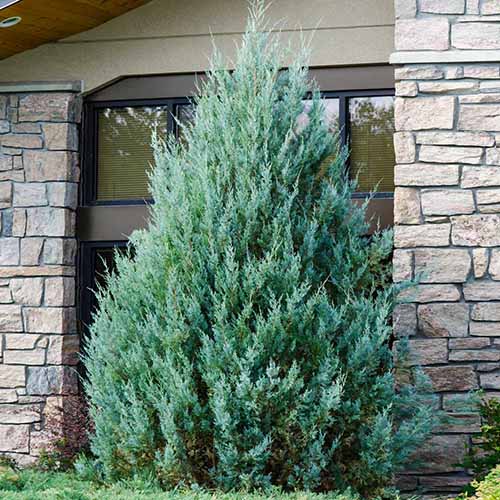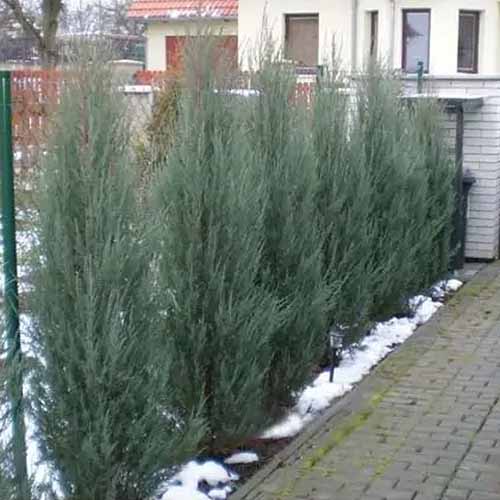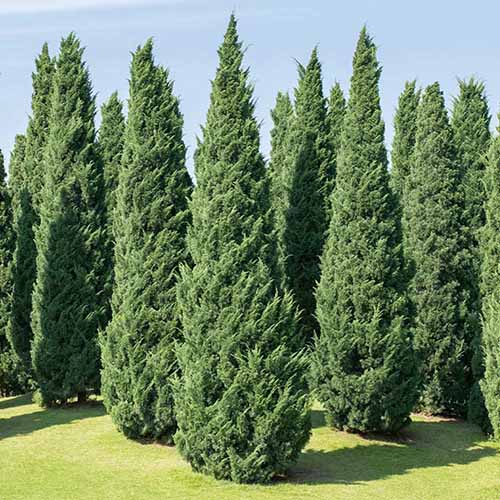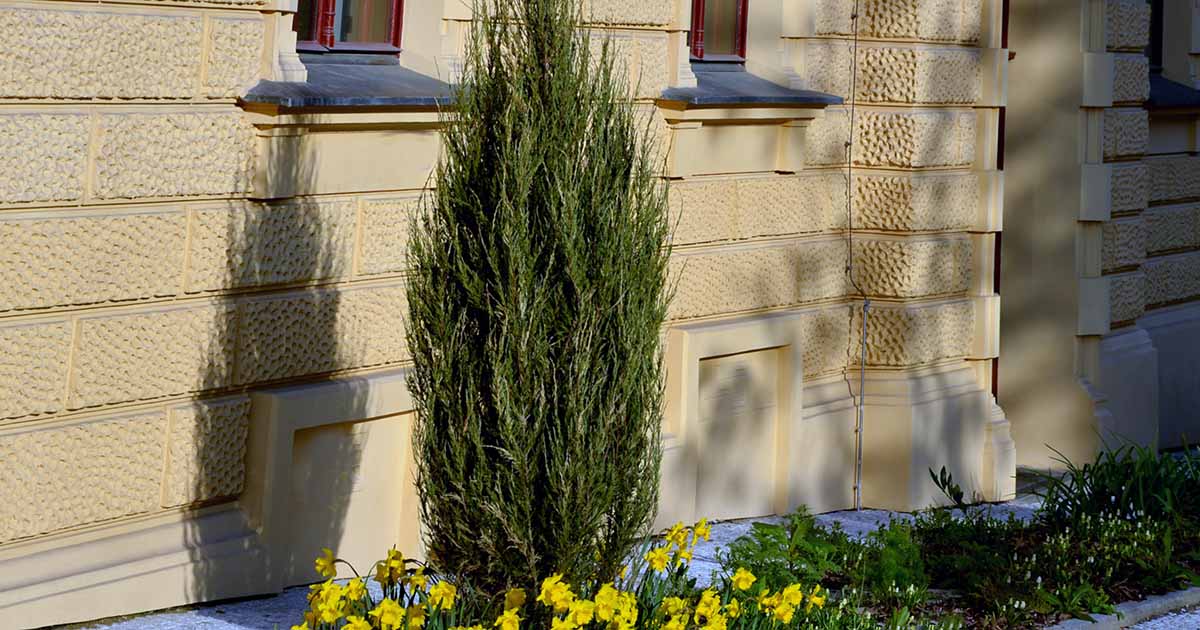
Upright junipers make a bold statement in the garden. Whether you have a stately ‘Spartan’ or a row of ‘Skyrocket’ shrubs, there’s nothing else like them.
Most upright junipers maintain their shape without any pruning or extra work on your part.
But prolonged heavy snow can bend branches, consistent wind from the same direction can cause uneven growth, and disease can damage sections of your tree.

We link to vendors to help you find relevant products. If you buy from one of our links, we may earn a commission.
To make your plant look better, it will need some pruning. The point of pruning is to maintain the plant’s existing shape or to tidy it up, not to change its shape.
So before we get started, here’s the bottom line: It’s going to be extremely difficult to prune a juniper with a naturally sprawling or round shape into an upright shape. You’ll need to buy an upright cultivar in the first place – it’s a good thing there are so many fantastic options available!
In this guide, we’ll cover how to trim your upright juniper, not to change the shape of an existing shrub.
Now that we’re all on the same page, here’s what we’ll discuss in this guide:
As I mentioned, there are lots of gorgeous upright junipers available. If you’re looking for some excellent options, here are just a few that I’m particularly fond of:
‘Witchita Blue’ is a big shrub, growing about 25 feet tall and up to eight feet wide.
While the steel blue foliage stands out, what’s particularly nice about this Rocky Mountain juniper (J. scopulorum) is that it’s quite bushy, with lots of soft growth. That means it can handle heavy pruning before you reach the woody stems.
This is one of those shrubs that you can actually prune pretty dramatically.
If you want an adaptable shrub, grab one in a two- to three-, three- to four-, or four- to five-foot height at Fast Growing Trees.
Or nab yourself one of the narrowest juniper cultivars out there. ‘Skyrocket’ is another Rocky Mountain cultivar, this one grows about 15 feet wide and an astonishing three feet wide.
It’s perfect as a statement specimen or with several in a row as a windbreak or living fence.
Nature Hills Nursery carries ‘Skyrocket’ in #1 containers at about two to three feet tall.
And to help you get started, we have a guide to growing ‘Skyrocket’ here.
‘Moonglow’ is a favorite of mine because the blue-green foliage has a hint of silver that resembles the reflected light from the moon.
‘Moonglow’
Grab one of these Rocky Mountain cultivars at Fast Growing Trees in one- to two-, two- to three-, or three- to four-foot heights in a single or six-pack.
Once mature, they will reach 15 feet tall and about six feet wide.
If you purchase and plant one of these, please visit our guide to growing Rocky Mountain junipers for cultivation tips.
If you already have an upright juniper and you’re looking for some trimming information, let’s get started with the tools you’ll need.
You can get away with a sharp, clean pair of bypass pruners, but I also like to have a pair of anvil and ratchet pruners on hand, depending on the tree or shrub I’m working with.
If you don’t want or need a bunch of different pruners, just stick to the old classic Felco F-2. They’ll get the job done just fine.
Amazon carries these gardening essentials.
If your plant has some larger branches you need to tackle, you’ll also want a saw or loppers. A tree saw can help you reach high branches, especially if you find one with a built-in lopper.
Something like the Milliard extendable pole saw/pruner available at Amazon is ideal for those taller junipers.
You should also wear gloves, since many junipers have sharp leaves. You might also consider donning a thick, long-sleeved shirt or some protective gardening sleeves.
You only have to get all scratched up by your juniper once before you avoid making that mistake a second time.
Timing
Pruning can be done anytime you want unless the air temperatures are below freezing. When the wood of a juniper freezes, the plant can be damaged or even killed by pruning.
To be extra safe, you should avoid pruning in the late fall, too. When you make cuts in late fall, it exposes the plant to winter damage.
On the other hand, pruning during a heat wave when the plant is already struggling to conserve water isn’t advisable unless it is absolutely necessary.

If you can wait, the best time to prune is in late winter or early spring. Early fall is slightly less ideal, but it’s still fine.
If you need to do a lot of pruning, spread it out over several weeks or even months, if possible. However, if your plant has a significant amount of damage or diseased limbs, it’s best to get it all done at once.
Pruning Technique
The tool and strategy you’re going to use to prune your upright juniper depends on the size of the branch or stem you’re cutting.
If you’re working with a piece of wood smaller than your pinky, just use those pruners. Anything bigger calls for a saw or loppers.

You can prune green growth to encourage bushiness and shape the plant. Only areas with green, soft wood will branch and develop new growth because new foliage emerges from the branch tips.
If you prune an older, woody branch back to where there aren’t any leaves, it won’t develop any new growth and you’ll be left with a bare stump.
As a rule of thumb, you should remove any branches or stems that don’t have needles. They won’t generate new growth. If you need to prune a branch back into the woody area that is devoid of needles, just take the whole thing off.
Small stems can be cut back to the main branch. Make a flush cut so there isn’t a stump left behind.
For larger branches, you want to make your cut so that the branch collar remains intact. The branch collar is a raised spot where the trunk transitions into the branch. When you’re done cutting, that little bump will remain.
To do this, take your saw or loppers and cut the branch a few inches out from the trunk. If you’re using a saw, it’s best to make the cut from below rather than above. Saw about halfway through and then start sawing from the top to meet the cut that you made from below.
Now that you’ve removed the weight you can make a precise cut. Use the saw or loppers to remove the rest of the branch at a slight angle so that the branch collar remains intact.
Remove any lopsided, ugly, or unusual growth. Anything diseased or discolored gets the chop.
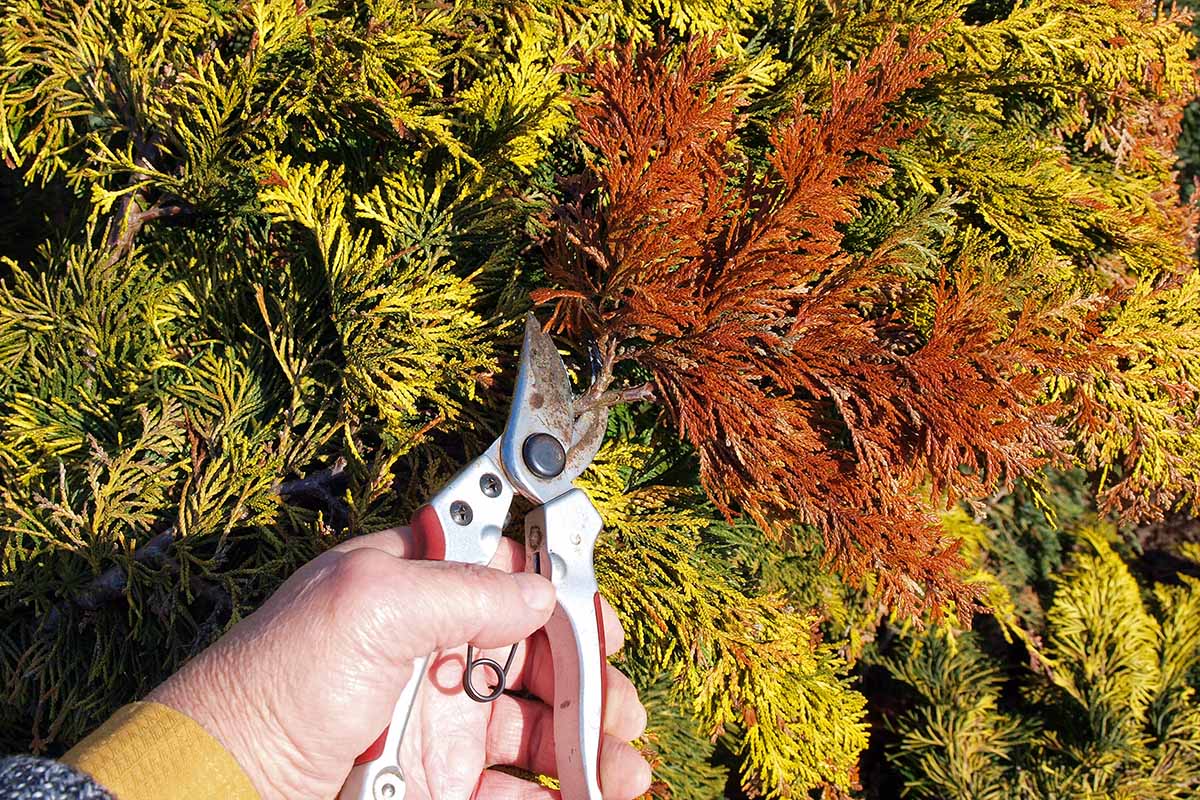
If you want to encourage bushier growth in an area that is a little sparse, cut the green ends to promote branching.
Remember, you don’t need to create upright growth, you’re aiming to support the natural shape of the tree.
If you want to flatten the top of the shrub, feel free, but make sure that you are only cutting into green growth. If as you flatten the top you cut into old wood, you’re going to have a little baldy on your hands.
What to Avoid
There are a few things to avoid when pruning upright junipers. First, don’t ever cut the main central trunk.
This is known as the leader and if you were to lop it off in the hopes of making your shrub bushier or to limit its height, you’ll only weaken the plant and leave it more susceptible to damage.
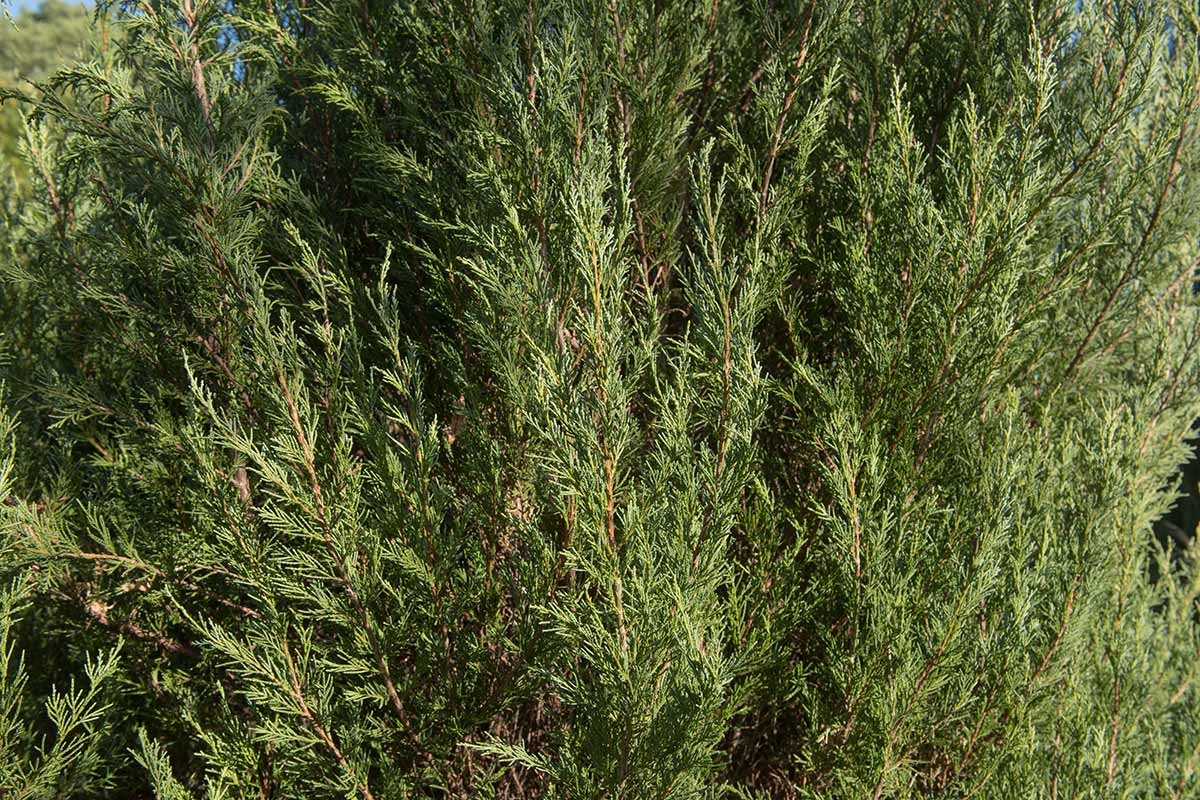
We’ve already mentioned it, but it’s worth repeating: don’t prune back into old wood and expect new growth.
You also shouldn’t seal any of the cuts that you make. I know it used to be common thought that you could protect the plant by sealing up any cuts, but most conifers do a fantastic job of protecting themselves.
That’s what the sticky resin that oozes out of these plants is for – it’s the plant’s natural defense.
Try not to prune more than a quarter to a third of the plant at one time. The exception to this is if your plant is badly damaged by disease, pests, or something environmental like wind or snow. In that case, it’s best to remove the problem wood to support the shrub.
Finally, please, please don’t shear your plants! It hurts my heart every time I see someone taking one of those electric trimmers to create a smooth line. That works great on some species, like boxwoods, but it’s not the right method for junipers.
Shearing not only runs the risk of creating an ugly bald spot, since you can’t be as accurate with your cuts, but it also creates a dense umbrella of growth on the outside of the shrub that shades the interior of the plant.
This causes needle drop and a thin shell of growth that isn’t supported by healthy interior growth.
If you want to shear just a small area here and there with some precision, go ahead, but don’t do it on the entire plant.
Just a Little Off the Top
When you’re pruning an upright juniper, you aren’t trying to create a topiary or change its natural shape.
The goal is to provide some support for the natural shape of the plant. I mean, look at these plants! They’re already stunning all on their own. All they need is a little assistance.
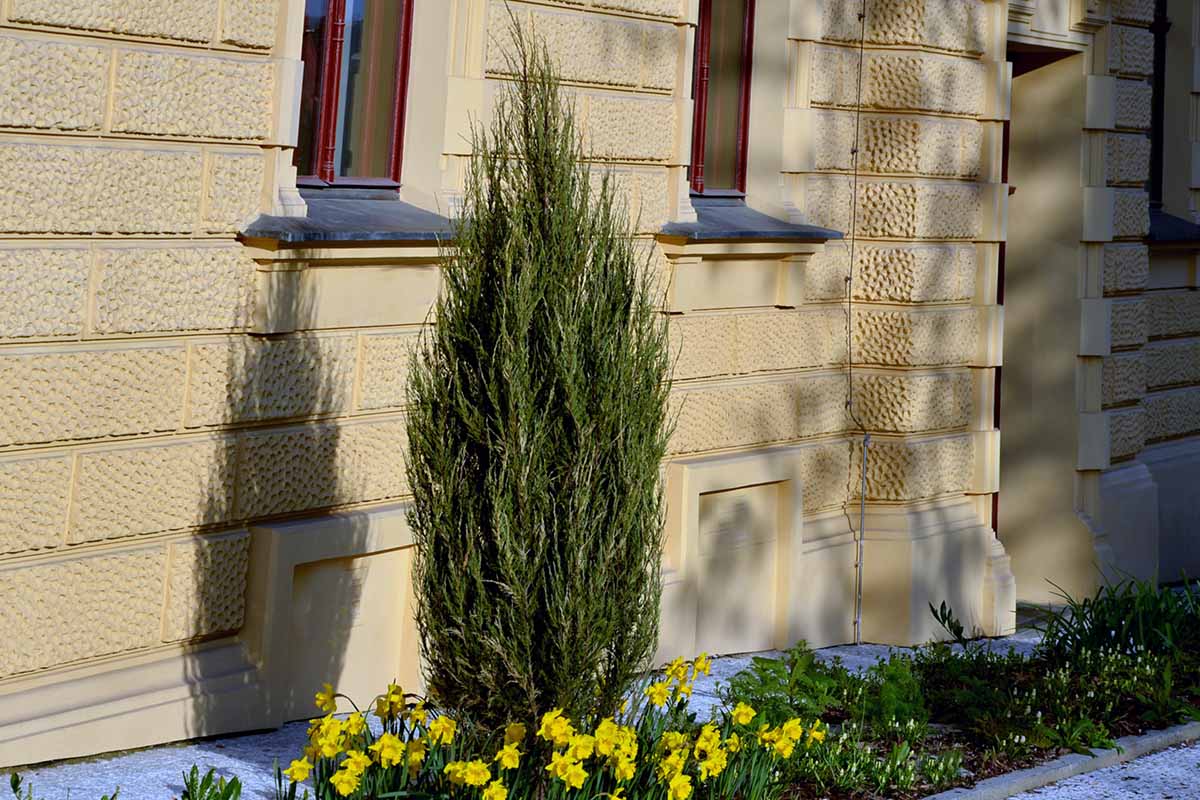
What kind of upright juniper are you pruning? Are you dealing with a disease or just providing a little shape? Share with us in the comments section below.
Hopefully you feel ready to head out there with your pruners and gloves and finish the job.
Once your plant is looking fabulous, you might want to learn a bit more about junipers. Here are a few guides to get you started:
